Recent Mold Remediation Posts
How Can Wallpaper Lead to Mold Growth?
2/8/2022 (Permalink)
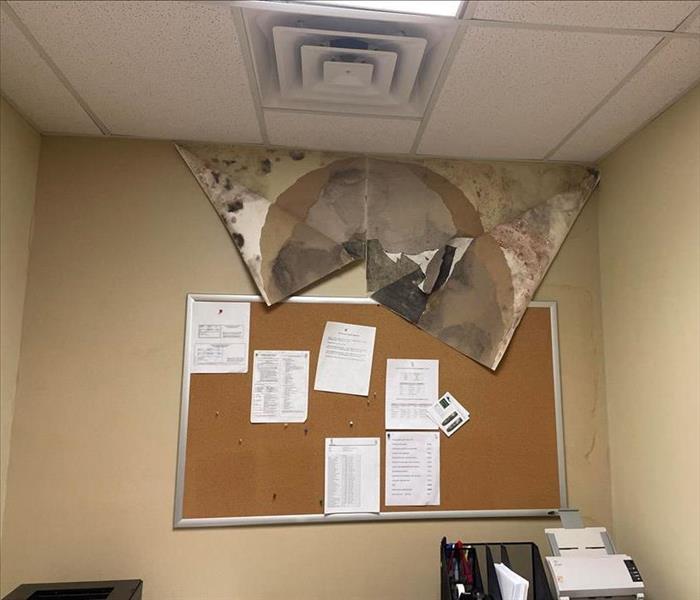 SERVPRO of Greater Covington and Mandeville specializes in mold remediation.
SERVPRO of Greater Covington and Mandeville specializes in mold remediation.
Decorative wallpaper is back in style. Interior designers and DIYers are using this popular 20th-century material to create accent walls or add texture to their spaces. Unfortunately, every restoration professional will warn you not to. Why? In certain conditions, mold will begin to grow behind wallpaper and can go undetected until becoming a major problem.
Buildings need to breathe. Air and moisture pass through building envelopes, diffusing slowly to stabilize water vapor pressure differentials between the environment inside and outside of the property. For example, weep holes provide airflow through brick and other masonry walls.
Wallpaper is essentially a vapor barrier. When moisture is trapped behind wallpaper, mold may begin to grow on the drywall, insulation, and framing inside the wall cavity. This is especially common in hot, humid environments where condensation may occur due to hot air outside and cold air inside clashing.
As mold remediation professionals, our team has found growth hiding behind wallpaper many times. If you choose to decorate with wallpaper, then our best advice is to avoid areas prone to water damage or rooms with high humidity. Never hang wallpaper on exterior walls or in bathrooms. The safest bet is to only apply wallpaper to interior walls that do not have plumbing running through them.
Some common indicators of microbial growth lurking behind wallpaper are stains or discolored patches, wallpaper edges curling upward, and a musky, mildew odor. If you notice one of these issues in your home or business and suspect microbial growth, then contact our office to schedule a site inspection today. Our team will help identify any moisture issues and create a remediation protocol if microbial growth is discovered.
Hidden Water Damage Can Cause Mold Growth
3/19/2021 (Permalink)
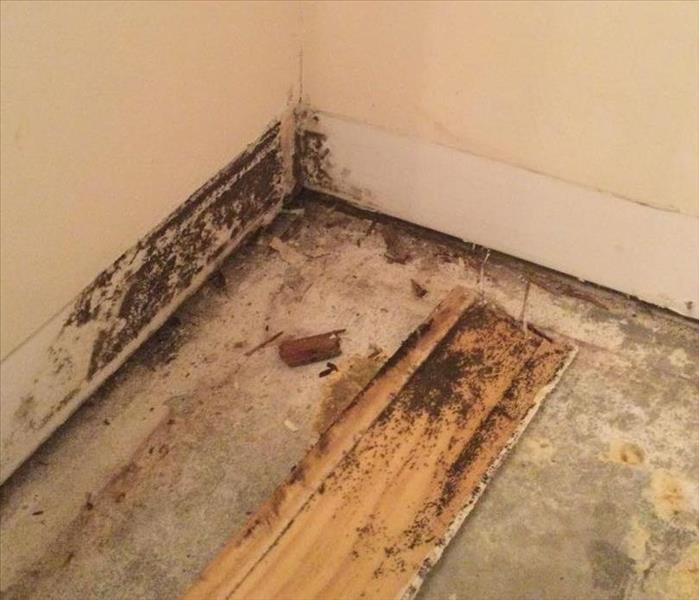 Trapped water can cause mold to grow in as little as 48 hours
Trapped water can cause mold to grow in as little as 48 hours
When a water damage event like a broken water pipe or an exploding water heater occurs, water will flow into many areas that are hard to see. You may think you have cleaned up all the loose water, but only a professional water mitigation team is trained to detect where water may be hiding. For example, water will usually flow underneath baseboards and wick up the drywall. This can cause serious mold growth issues because the water is trapped, and the drywall will not be able to dry properly. During our initial investigation process, our water damage restoration technicians will remove baseboards to extract water behind them and allow the materials to dry. As pictured above, water was hiding behind this baseboard. The trapped water allowed mold to grow in a very short period. In the right conditions, mold can begin to grow in as little as 48 hours. Thus, it is best to contact a professional restoration company when a water damage event occurs in your home or business. Our water damage restoration team here at SERVPRO of Greater Covington and is highly trained and experienced in detecting hidden water to prevent future damages. Also, our emergency response team is here to help 24/7. For more information about water damage cleanup, please contact our office by dialing 985-871-5375.
Continuing Education Class: Understanding Mold in the Restoration Industry
1/28/2020 (Permalink)
Are you an insurance professional in need of continuing education hours? On March 12, 2020, we will be offering the two hour class Understanding Mold in the Restoration Industry at our office located at 68424 James Street in Mandeville. In this class, the insurance professional can expect to learn proper techniques for mold remediation, gain a better understanding of mold growth, and be more aware of how mold has affected our society. The class will be taught by the owner of SERVPRO of Greater Covington and Mandeville, Stuart Andrus, free of charge for all local insurance agents and adjusters. Coffee and a light breakfast will be provided for attendees. Check in will begin at 8:00 am and the class will run from 8:30 am until 10:30 am. To register or for more information about the class please send an email to kayla@SERVPROofcovington.com.
Four Mold Myths Debunked
7/22/2019 (Permalink)
Myth #1: Your house and business can and should be totally free of mold.
Truth: Microscopic spores are all around us, both indoors and outdoors. Tiny, invisible to the naked eye mold spores enter our homes and businesses through open doors and windows, heating and air conditioning systems, and can even be carried in by our pets. If you were to have an indoor air quality professional or an industrial hygienist conduct a mold test in your home or business, then you would learn every indoor space has an acceptable or natural mold spore count. The problem arrives when you have an elevated mold spore count or see visible mold growing on materials inside your property. In those cases, you should contact us immediately for mold remediation services.
Myth #2: Black mold is toxic.
Truth: Thousands of different mold species have been scientifically identified in the United States. Some molds appearing to be black are actually a dark green color. The most commonly known dark green mold species associated with health concerns is Stachybotrys chartarum. However, not all dark green or black colored molds are Stachybotrys. Regardless of which specific species of mold you may have in your home or business, you should have it removed. Also, despite the particular species, all microbial growths should be remediated using the same method: position containment around the affected area, stabilize the environment, removed affected porous materials, clean and disinfect remaining nonporous materials, and "scrub" the contaminated room with a HEPA air scrubber. Please note, the source of the issue must first be identified and resolved.
Myth #3: Bleach kills mold.
Truth: Bleach does not kill microbial growth. Bleach will discolor the mold spores for a short period, but the mold will continue on growing. Eventually, you will notice colored microbial growth again. Also, as previously stated, microbial growth is caused by a moisture problem and the original source must be corrected. Applying bleach to the affected material will only amplify the moisture problem.
Myth #4: You can remediate mold yourself.
Truth: While you may be very capable of removing affected materials, like drywall and carpet yourself, without the necessary professional equipment and expertise you risk spreading the microscopic mold spores throughout more rooms in the property. Remember, the first few steps in our mold remediation process are to set up containment around the affected area and to stabilize the environment. Our protocol works to prevent the spreading of microscopic spores by protecting the unaffected areas. By utilizing negative airflow and air scrubbers with HEPA filters, our mold remediation technicians can not only remove microbial growth but also protect the rest of your home or business. Our mold remediation technicians are trained and certified to properly remove microbial growth. Trust our professionals.
For questions regarding indoor microbial growth issues or for a mold remediation quote, please contact our office by dialing 985-871-5375.
How to Prevent Mold From Growing in Your Bathrooms
7/22/2019 (Permalink)
One of the most common rooms in a home conducive for microbial growth is the bathroom. Mold only needs three things to grow: moisture, a food source, and time. Bathrooms are naturally more humid environments and grime left after baths and showers contribute as a regular food source for microscopic mold spores to feed on. To prevent mold from growing in your bathroom make sure to alleviate as much moisture as possible following each use. Use the vent while showering and leave it on for an extra five minutes or so when you leave. If you do not have a vent in your bathroom, then consider installing one or open a window or door during shower time. If it isn’t more humid outside, then this should help. However, this certainly wouldn’t be helpful during summertime in Louisiana. Installing and regularly using a vent is the best preventative action. Another way to remove moisture from your bathroom is to wipe down or use a squeegee in the shower, tub, and basin after each use. This may prove to be tedious but trust us it’s less of a headache than having to renovate your bathroom because of a mold problem. If you have recently discovered mold growing in your bathroom, then please give us a call now to schedule an appointment with one of our mold remediation technicians. Our office number is 985-871-5375.
What is Black Mold?
2/25/2019 (Permalink)
"Black mold", formally known as Stachybotrys chartarum or Stachybotrys atra, is only one species of mold. Stachybotrys chartarum often appears black or dark green in color. Stachybotrys chartarum can grow on materials with high cellulose and low nitrogen content, such as fiberboard, gypsum board, paper dust, and lint. Now, there are thousands of unique species of mold in the world. Not every dark green or black colored microbial growth is Stachybotrys chartarum. Other species of molds may look similar in color. In order to be certain of which species of mold you have discovered growing in your home or business, you must have an Indoor Environmental Professional or Industrial Hygienist test for mold. The mold testing professional will take samples of the air quality inside of your home, of the suspected microbial growth, and of the air quality outside of your home. The samples will then be sent to a lab for testing. In less than one week, the professional should send you the test results and explain the findings. Any excessive amount of mold spores in your home should be addressed by professionals like our mold remediation team at SERVPRO of Greater Covington and Mandeville. "Black mold" or not, an excessive count of mold spores affects your home's air quality. For questions regarding mold remediation or to schedule an appointment with one of our certified mold remediation technicians, please contact our office by dialing 985-871-5375.
Notice a Moldy Smell in Your Home or Business? Here's How You Should Respond.
2/18/2019 (Permalink)
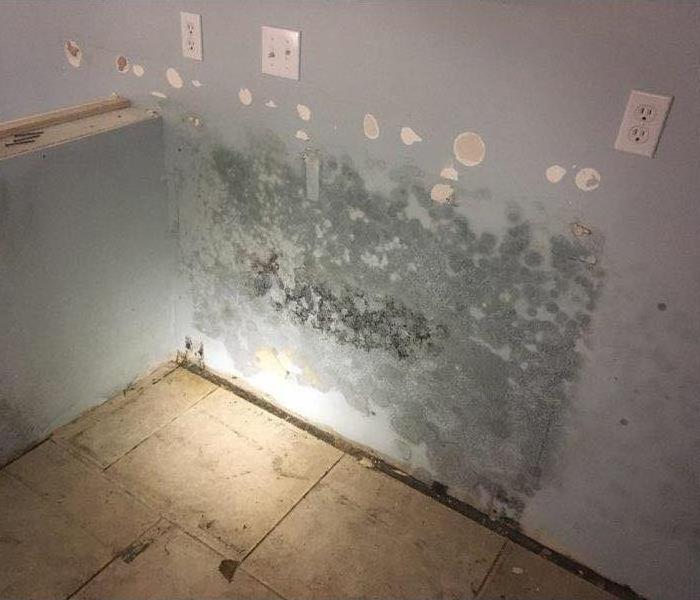 Does it smell like mold is growing in your home or business?
Does it smell like mold is growing in your home or business?
Most people learn their home has a mold issue either by discovering visible mold growth or by smelling a “moldy” odor. Mold growth produces gasses called microbial volatile organic compounds (MVOC). Depending on the species of mold, the microbial volatile organic compound gasses can either be odorless or carry a distinct moldy smell. People often describe this moldy smell as musty, as if something inside of the pungent room is wet. If you notice this smell in your home or business, but do not see visible mold growth, then you should contact an industrial hygienist or indoor air quality professional to have the property tested for elevated mold spore counts. The professional will take air samples from multiple rooms in your home or business. They will also swab specific materials in areas believed to be affected and take samples from the air outside as a base to compare mold spore counts. Often the heating and air conditioning system is tested as well as mold spores will travel throughout the property through this channel. The samples are then sent to a lab for testing. Within a few days, the mold testing professional will send you a copy of the test results and explain their findings. Once the location of the mold growth has been determined our mold remediation technicians can devise a plan to remove affected materials and rid your home or business of an excessive mold spore count. To learn mold about our mold remediation process or to schedule an appointment with our mold remediation project manager please call our office by dialing 985-871-5375.
Mold Removal with Air Scrubber
9/17/2018 (Permalink)
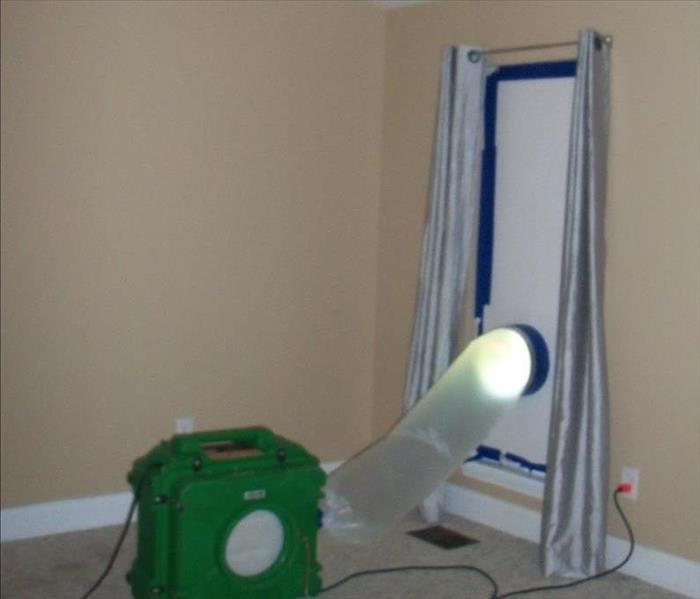 Microscopic mold spores are filtered through an air scrubber
Microscopic mold spores are filtered through an air scrubber
Part of the mold remediation process includes removing mold spores from the air of the affected space. This piece of equipment can serve as either a negative air machine or a HEPA air filtration machine. HEPA stands for high-efficiency particulate air.
During the mold remediation process, we first set up containment around the affected area to prevent further spreading of particulates. Then, we either use this machine to create negative air and pump air outside of the area or we can utilize this machine as an air filtration device. When used as an air filtration machine, or "air scrubber" as it is commonly called, air passes through a two-stage filtration system and the HEPA filter captures 99.97% of smaller particles down to 0.3 microns.
How Do You Know If It's Mold?
8/6/2018 (Permalink)
Do you have visible microbial growth in your home? How can you tell if it is indeed mold or specifically which species of mold it is? There are at least twenty thousand different species of mold that have been scientifically identified. The only way to determine if the microbial growth in your home is mold or not is to have the growth tested by an Industrial Hygienist or an Indoor Environmental Professional. SERVPRO of Greater Covington and Mandeville does not perform mold testing due to our ethical standards. However, we are happy to refer you to someone who is a trusted Indoor Air Quality and Mold Inspector in our community. When testing for mold the Indoor Environmental Professional will take samples of the air inside of your home or business and also a sample of the air outside to compare mold spore counts. The Indoor Environmental Professional will also swab the suspected mold growth. The samples collected will then be sent to an AIHA accredited laboratory for analysis and you can expect results in a few days. If you have any questions or would like more information about hiring a reliable Indoor Air Quality and Mold Inspector on the Northshore, then please feel free to give us a call at 985-871-5375.
Mold vs. Mildew
8/3/2018 (Permalink)
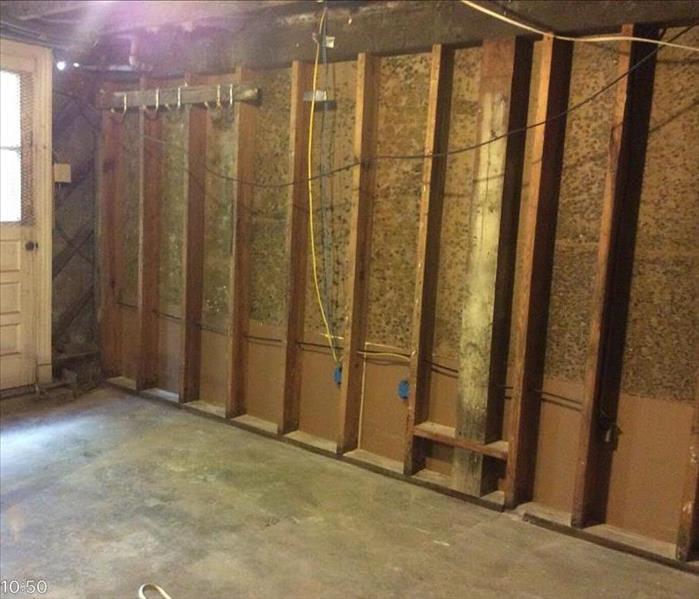
What's the difference between mold and mildew? This is a fairly common question our mold remediation technicians are often asked. Both mold and mildew thrive in humid, warm environments. Also, mold and mildew are equally able to grow on an array of surfaces, from food to drywall to kitchen cabinets. Mold and mildew do differ in size, texture, and color though. Mildew is a surface fungi that tends to be gray or white in color and is usually found on a moist surface. Mold is usually green or brown in color and sometimes may even seem to look fuzzy. Discovering mold growth inside of your home of business is typically the result of a much larger issue. While mold and mildew share a few similarities, their most significant difference is how they should be removed. Mildew can easily be removed by simply wiping down the affected area with store bought chemicals. Mold remediation needs the attention and expertise of trained professionals like our SERVPRO of Greater Covington and Mandeville technicians. We may need to recommend removing certain affected materials. Furthermore, we utilize antimicrobial agents specifically formulated by chemist for mold remediation. To learn more about our mold remediation process please click here. To prevent either from growing in your home or business read these tips. If you have suspect mold growth in your home or business, then please give us a call immediately at 985-871-5375.
Moisture Control is the Key to Mold Control
7/23/2018 (Permalink)
Mold spores can be found all around us, both indoors and outdoors. However, for mold to become a problem inside a home or business water damage must occur. Water damage can materalize in the form of an actual leak or spill, water buildup over time, or high humidity levels causing heavy condensation to accumulate inside.
Controlling Moisture by Preventing Water Damage
If you notice a water leak or spill, then you must act quickly to prevent mold growth and further damages. First, stop the source of the water intrusion. You may need to contact a plumber for help finding the root of the issue. Second, you need to extract the water and make sure to properly dry all affected materials. SERVPRO of Greater Covington and Mandeville is available 24/7 for emergency water damage restoration. Remember, in as little as 48 hours mold can begin to grow on wet materials.
To prevent water buildup make sure to regularly inspect your home. Clogged or broken gutters can often leave to water damage and thus, mold growth. Every couple of months clean and make any necessary repairs to your gutters. Water can also buildup around your home if the ground does not correctly slope away from the foundation. If you notice water building up around your foundation, then take measures to guide water away from your home. To learn a few ways to keep water flowing away from your home click here. Lastly, inspect your air conditioning system on occasion to ensure water is not collecting in the drip pan and the drain lines are flowing accurately.
Controlling Moisture by Controlling Humidity
Keep indoor humidity low. If possible, keep indoor humidity below 60 percent relative humidity. To measure the humidity level in your home you can purchase a moisture or humidity meter from a local hardware store for about ten to fifteen dollars. Utilizing your air conditioner and, if necessary, a de-humidifier will help to control the humidity in your home. Also, running the bathroom fan when showering and using the exhaust fan or opening windows when cooking will help decrease humidity levels. Lower humidity levels will help to prevent condensation from forming and potentially leading to mold growth.
SERVPRO of Greater Covington and Mandeville specializes in mold remediation for both residential and commercial properties. To learn mold about our mold remediation process, then please click here.
The Mold Remediation Process
1/22/2018 (Permalink)
First and foremost, the moisture source of the mold growth must be eliminated or fixed before cleaning can begin. If you notice a water leak, please contact a plumber immediately.
Mold remediation can simplified into three steps:
- Control Environment-Set up containment, air filtration equipment and negative air flow to control environment and prevent further contamination.
- Remove and Clean- Remove and properly dispose of all porous materials contaminated with mold. Clean all nonporous materials contaminated with mold, HEPA vacuum, and apply anti-microbial agent.
- Dry Structure- Dry structure to reduce moisture levels below that which enables growth. Obtain final clearance testing from Indoor Environmental Professional (IEP).
SERVPRO of Greater Covington and Mandeville specializes in mold remediation for both commercial and residential buildings. If you notice mold growing in your home or business, please give us a call today at 985-871-5375.
Interactive Mold House Tour
1/15/2018 (Permalink)
The United State Environmental Protection Agency's (EPA) website is a great resource for learning about mold and mold cleanup. For the most part, mold growth in your home or business is easily preventable. Moisture control is the number one key to stopping microbial growth in a property. Keeping the humidity level low, fixing any water damaged materials, and responding quickly to pipe leaks can save you a lot of time and money in dealing with mold damages. The EPA has created an interactive mold house tour to highlight how mold can become a problem in certain areas of your home and what you can do to prevent this from happening. To view the interactive mold house tour please click here.
If you suspect mold growing in your home or business please give us a call today at 985-871-5375.
Free Continuing Education Class- 2 credits
9/22/2017 (Permalink)
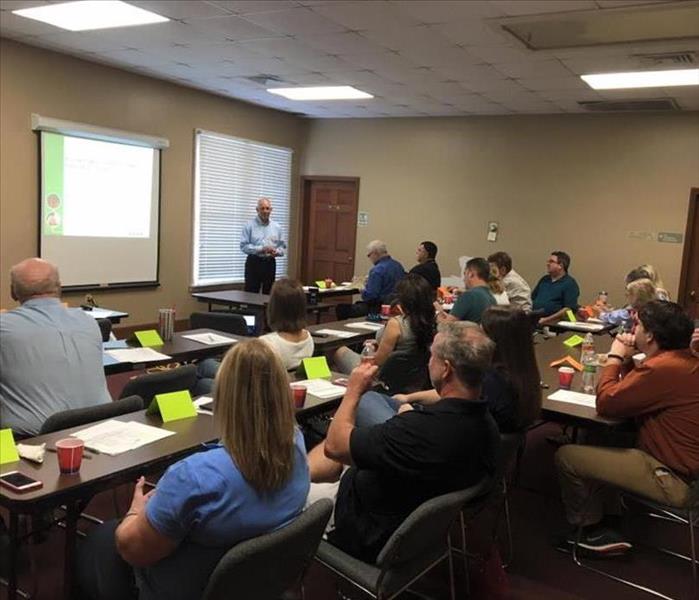 "Understanding Mold in the Restoration Industry"
"Understanding Mold in the Restoration Industry"
We invite all local insurance professionals to our upcoming continuing education class, "Understanding Mold in the Restoration Industry", on October 24th. The class will held at the St. Tammany West Chamber of Commerce located at 610 Holycrest Blvd. in Covington. Registration is for 10:30 am and the class will be from 11:00 am to 1:00 pm.
What you can expect to learn:
The insurance professional will gain a better understanding of how mold affects today’s society. They will also become more aware of the different entities that participate in the mold restoration industry.
The insurance professional will learn about mold, mold growth requirements, and the goals of mold remediation followed by professional vendors.
For more information and to register please send an email to kayla@SERVPROofcovington.com.
Tips For Preventing Mold Growth
8/10/2017 (Permalink)
In as little as 48 hours, mold can quickly become a problem in your home or business when there’s a water intrusion, like a roof leak or leaking water line. Mold can cause health effects and can also cause significant damage to your property.
To prevent mold growth follow these tips:
- Keep the humidity between 30 to 60 percent
- Provide for proper drainage away from building foundation
- Regularly inspect plumbing and appliances for leaks
- Keep gutters and drains clear of debris
- Inspect the roof, windows, and other areas where water might enter the building
- Keep heating, ventilation and air conditioning (HVAC) drip pans clean, flowing properly, and unobstructed
- Respond to all water intrusions immediately
To learn more about our mold remediation process click here.
Attention Louisiana Residents: Follow These Mold Safety Tips If You Suspect Mold
8/9/2017 (Permalink)
If you notice visible mold growth in your home we urge you not disturb it. You can inadvertently spread the microscopic mold spores throughout your entire home.
What to Do:
- Stay out of affected areas.
- Turn off the HVAC system and fans.
- Contact SERVPRO of Greater Covington and Mandeville for mold remediation services.
What Not to Do:
- Don’t touch or disturb the mold.
- Don’t blow air across any surfaces with visible or suspected mold growth.
- Don’t attempt to dry the area yourself.
- Don’t spray bleach or other disinfectants on the mold. Bleach does not kill mold spores.
About Our Mold Remediation Services
SERVPRO of Greater Covington and Mandeville specializes in mold cleanup and restoration. Our crews are highly trained mold remediation professionals that use specialized equipment and techniques to properly remediate your mold problem quickly and safely.
If You See Signs of Mold, Call Us Today – 985-871-5375
To see examples of the mold remediation process click here.
Louisiana Humidity and Mold Growth in Your Home
1/26/2017 (Permalink)
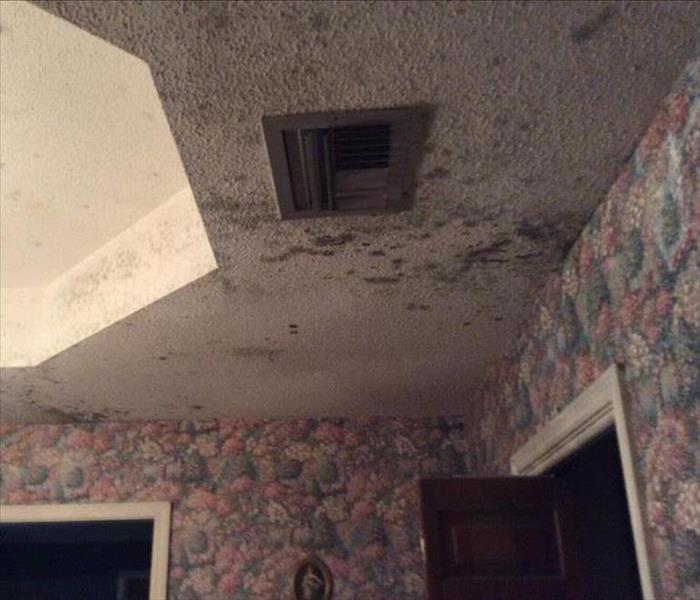 Mold growth
Mold growth
South Louisiana is unique for many reasons. The South is colored with great food, spirited celebrations of life and diverse groups of people. The South is also known for being very, very humid. Sometimes this humidity finds its way into our homes. With the right conditions of humidity and a simple water leak, mold can begin to grow in your home and create an unhealthy living environment for your family. According to the United States EPA, molds can produce allergens, irritants and in some cases, potentially toxic substances. Reactions to molds in your home or business can be immediate or delayed. If you notice mold growth in your home or business you should contact SERVPRO immediately. Our highly trained professional technicians use advance mold remediation techniques and equipment. We're experienced with mold remediation after disasters and even common water leaks in commercial and residential buildings. Don't ignore the mold growth in your home or business any longer. Your health and well being can be affected.
For more information on mold you can visit www.epa.gov/mold
To learn more about our mold remediation process click here.






 24/7 Emergency Service
24/7 Emergency Service





